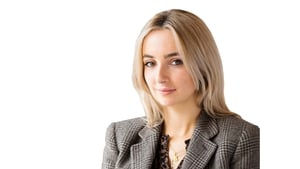It's a great time to be a Gaeilgeoir. Now more than ever. Kate Demolder meets the creators of GaelGoer, the new Google Maps-style app that has carved out a space of welcome interaction for anyone who craves a cúpla focal.
In the first few months of 2019, Noreen Breen, a retired primary schoolteacher based in Dublin City, came to understand that she lived in an Ireland full of Irish speakers, all of them too modest to make themselves known.
We need your consent to load this Instagram contentWe use Instagram to manage extra content that can set cookies on your device and collect data about your activity. Please review their details and accept them to load the content.Manage Preferences
During her visits to shops, hairdressers, cafés and local businesses, she noticed people would speak back to her in Irish if she began the conversation, but rarely volunteered it first. She spoke the language well and noticed a number of people around her did too, but none of them knew about each other, and thus couldn’t communicate.
They were also out of practice, embarrassed, and linguistically stunted from years of fear around speaking it. From months of manual-heavy researching, she found a number of Irish-speaking people working in pubs, shops, cafés and facilities near her.
She asked them to wear a badge reading 'Labhair Gaeilge Liom’ (speak Irish to me) in an effort to encourage others to do the same. "The thought process was actually based around the Irish seanfhocal "Aithníonn ciaróg ciaróg eile," (It takes one to know one)," Breen tells RTÉ. "But Irish speakers don’t recognise each other at all."
The result of her heady, aspirational, grassroots experiment indicated that, on average, 3.6 customers spoke to those wearing badges in Irish every day over a two-week period, as opposed to zero who spoke when not. "I was taken aback by how many opportunities I was missing to speak our native language due to being unable to identify fellow Gaeilgeoirí," Breen says. "We couldn’t be happier to get the app off the ground and we can’t wait to welcome the wider Irish-speaking community to the platform."
We need your consent to load this Instagram contentWe use Instagram to manage extra content that can set cookies on your device and collect data about your activity. Please review their details and accept them to load the content.Manage Preferences
The outcome is GaelGoer, a new, free app that aims to connect Irish speakers of all levels, by identifying locations and events where Irish is spoken, and the people who are willing to speak it. Constructed in a similar manner to Google Maps, Gaelgoer indicates locations around the world ("London, Boston, Brussels… We presently have two registered Irish speakers in Africa!") where Irish is or can be spoken, alongside the name of the person in each environment who has registered their interest in speaking.
It holds high the beacons of enthusiasm and a desire to learn, welcoming all levels, whatever tense they’re able to speak in. The software––elegant, clean and easy-to-use––is the work of Head of Technology and Innovation at DataDyne Consulting, Luke Middleton, whose experience with Irish mirrors a myriad.
"My Irish is very poor, which is bad to say after 14 years of teaching" he laughs. "I wish I had a better grasp on it. I’m quite interested in using myself as a case study as GaelGoer grows, to see how much I can improve. My fiancé is also fluent, so she’s been using this time to kick me into shape."
Breen learned about Middleton’s prowess through his parents, her friends, who two years before she committed to researching, spoke proudly about their son Luke’s gold medal winning achievements for his work with apps in Trinity College. Middleton smiles as she retells the story, for what I imagine is the 10th time. "Sure, who else could I have asked to help me?"
We need your consent to load this Instagram contentWe use Instagram to manage extra content that can set cookies on your device and collect data about your activity. Please review their details and accept them to load the content.Manage Preferences
Using state-of-the-art technology, including geo-fencing, Gaelgoer’s main functionality at present exists in three ways:
- Anseo: This indicates the premises and businesses where there is an Irish speaker, of any level of proficiency, willing to speak Irish to customers. The location will appear on the app when a registered GaelGoer user is on the premises.
- Imeachtaí: This will give information on events in Irish.
- Lámh Suas: This will inform users of the presence of another GaelGoer user in their vicinity and offer the opportunity to contact that person via an instant messaging system built into the app.
Further functionalities are currently being considered ("everything from autocorrect to voice-to-text to Tinder as Gaeilge") with plans to create individual profiles for users to connect in ways traditional social media platforms have us used to. "I’ve been to the Oireachtas and other Irish-speaking events and spoken to lots of people about our app," Breen says. "The young people are very enthusiastic."
With that in mind, I set out on a Tuesday morning to complete a myriad of errands entirely as Gaeilge, with help from GaelGoer. First up, I went to Mellons Shop & Deli on South Lotts Road, a charming pile-it-high newsagent serving everything from 99s to Kerrygold to vapes to newspapers, resplendent with an extensive deli.
Existing within the family for generations, shopkeeper Colm spoke to us proudly and delightedly about how Mellons came to be, and how he stocks Bean in Dingle coffee in his Dublin 4 shop. Tall and smiling, he tells us his wife is from Kerry (the notice on the shop front which informs customers that Gaeilge is welcomed here is in Dingle Irish) and that he’s noticed a number of Irish-speaking punters since the app’s inclusion of his shop. We grab a coffee, admire the deli and move on.
We need your consent to load this Instagram contentWe use Instagram to manage extra content that can set cookies on your device and collect data about your activity. Please review their details and accept them to load the content.Manage Preferences
Next to Dunne’s Hardware on Wexford Street where one may speak to Seán or Tony in Irish. "Fáilte róimh isteach! Ba bhreá linn bheith ag caint libh." ("Welcome! We’d love to speak Irish with you all.") the shop’s profile on GaelGoer reads.
We chatted with Tony, a Galwegian long-settled in Dublin, with beautiful memories of beaches in Connemara and extensive knowledge of what sort of lightbulbs we needed for our home. He seemed genuinely thrilled to speak to us, as did the fellow punters behind us in the queue. His shop, too, boasted a ‘Gaeilge welcome here’ notice in the window––something we perhaps should be reminded of more; how many things we miss when we’re hurrying through life.
From there, we headed for Ballyfermot. Glic Café, a charming set-up located on the site of the sprawling Longmeadows Pitch and Putt course, boasts three employees with a command of Irish, as well as a local Gaeilge-speaking group, who meet up twice a week for a caife and a comhrá.
We happened upon them this Tuesday, joining in on conversations about what they’d watched on TV that week and where they all grew up. They were thrilled and delighted, as were we, to tell us about Liffey Gaels, their local GAA club, which promotes the Irish language through classes and meet-ups. It gave us hope, and a laugh, to see such pockets of activity. Not least in the back of a pitch and putt café we’d almost driven right by.
We need your consent to load this Instagram contentWe use Instagram to manage extra content that can set cookies on your device and collect data about your activity. Please review their details and accept them to load the content.Manage Preferences
According to TEFL, the internationally recognised entry-level credential for teaching English as a Foreign Language in schools and communities, nearly two billion people study English as a foreign language—about four times the number of native speakers. And, today, apps like Google Translate make it possible to communicate, almost anywhere, by typing conversations letter-by-letter into an internet-connected device (presuming your conversational partner can read).
Ironically, however, as the hegemony of the English language decreases the need to speak anything else for work or travel, the cachet attached to learning others seems to be growing. A number of thriving online communities in Ireland of ardent linguaphiles who are, or who aspire to become fluent Irish speakers exist, bolstered by Facebook groups, comhrá cainte (Irish-led conversations), and music fans (largely influenced by artists such as Belfast hip-hop trio Kneecap and Dublin rapper Selló).
These and much more have attracted a number of aficionados to try their hand at the language they’d largely forgotten about since school. Most recently, Maynooth actor Paul Mescal was lauded for speaking in Irish, botúin (mistakes) and all on the red carpet, as TG4 followed him, the Banshees of Inisherin, cast and An Cailín Ciúin, Colm Bairéad’s remarkable film, to the 2023 Academy Awards.
We need your consent to load this YouTube contentWe use YouTube to manage extra content that can set cookies on your device and collect data about your activity. Please review their details and accept them to load the content.Manage Preferences
No one becomes an Irish speaker without trying. While one might have boasted proficiency in school, generally one’s grasp of the language erodes so gradually through the years that there is never really a definitive moment when their vocabulary became less extensive or their grammar less polished.
It also generally doesn’t occur to those with waning skills that their second, or third, or fourth language is regressing until it’s too late.
Gaelgoer gives the tools we civilians lack, noticeably those which are held back by our own scepticism, shame or fear of failure.
As Conradh na Gaeilge celebrates its 130th year, allow yourself to embrace the language once relegated to Leaving Certificate grinds books and Gaeltacht brochures once more. Not least because you know more of it than you realise, but because without it, we’d be less the fascinatingly sly elements that make the language what it is (the same word in Irish, francach, can be used for both ‘Frenchman’ and ‘rat’), you’d have no way to discuss demented carry-on while abroad, and because, in a number of instances, it actually saves your soul (anyone who orders their pint as Gaeilge in Hynes’ Bar, Stoneybatter gets a €1 off).
"If we lose the Irish language, we lose our native literature," Mairtín O’Cadhain, the crude, Joycean author and former staunch republican once said. "We’ll be finished as a people. The vision that every generation of Irish people had will be at an end."
Gaelgoer is available to download via iOS and Android. For more information, check out gaelgoer.ie.
The views expressed here are those of the author and do not represent or reflect the views of RTÉ.

